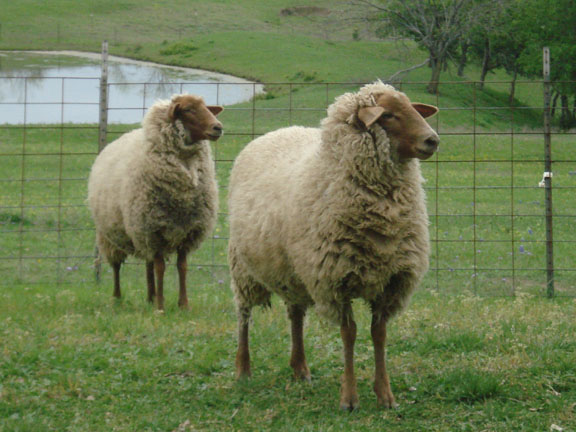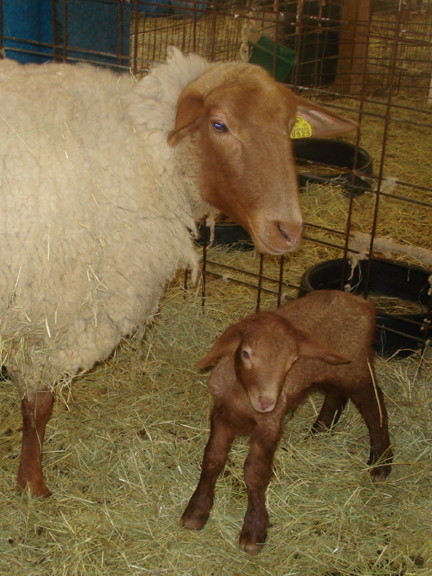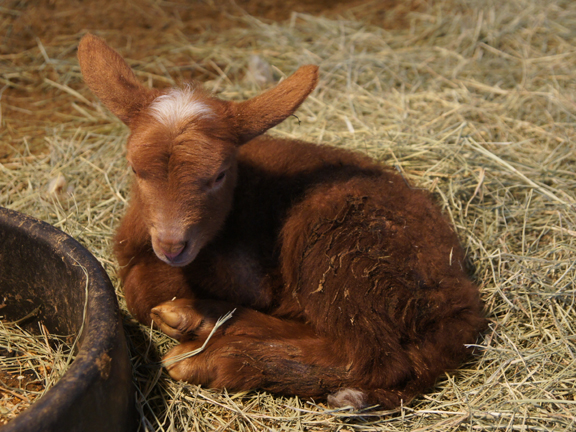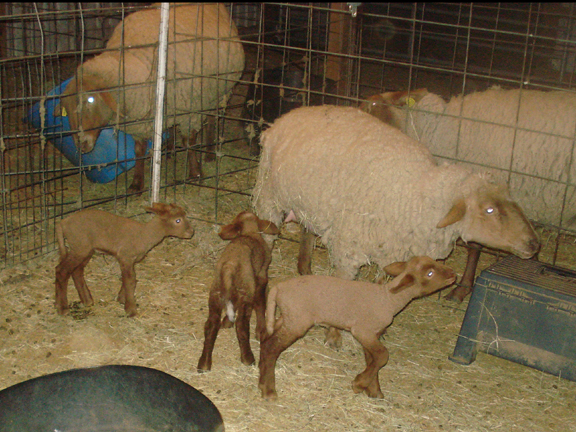Tunis Sheep





Tunis Breed Standard
(from the NTSRI website)
PURPOSE:
The purpose of this Breed Standard is to define the Tunis sheep breed. The Registry considered the diverse opinions about whether the Tunis is best characterized as a mutton breed, multipurpose breed, wool breed, rare breed or some combination of these. After much deliberation, the Breed Standard was developed using the guidelines set forth at the inception of the National Tunis Sheep Registry, Inc. in 1929. The Registry believes that the Tunis should be preserved as a unique, and distinct, breed and should not look like any other breed. The Registry further believes that Tunis sheep should be graded on their value as breeding stock. For this reason, this Breed Standard was developed to define the Tunis as the first red-faced American sheep breed and to differentiate it from all other breeds.
Tunis sheep should be shown or exhibited in breeding condition with a body condition score of 2.5 to 3.0 rather than being shown or exhibited in an underfed or a too fat condition. Yearlings or mature animals may be exhibited slick shorn or with no more than 1″ of unblocked wool at the owner’s discretion. Lambs may be exhibited in full fleece.
GENERAL CONFORMATION:
CHEST: deep and only moderately wide. An excessively wide chest has been found to interfere with ease of lambing and reduces travel endurance.
BACK: wide, of medium length, with normal curvature and exhibiting no evidence of spinal deformity, i.e., kyphosis (abnormal anterior or posterior curvature of the spine, weakness behind the shoulder, or swayback), lordosis (roachback), or scoliosis (lateral curvature of the spine, deviation to the right or to the left). The height at the pins should be equal to or slightly lower than the height at the withers, denoting a pelvic angle conducive to lambing ease. The rump should slope toward the tailhead. The loin should be well-developed and the hindsaddle should measure more than one-half the length of the back when measure from the 13th (last) rib to the dock.
LEGS: The hindquarters should be wider than the forequarters, with a good leg of mutton. The hind legs should not be cow-hocked or bow-legged. While pasterns should be straight, they should be resilient rather than stiff to aid in walking on rough terrain. Front legs should not be set too wide apart as this interferes with easy lambing. A prominent brisket is to be discouraged as this indicates a wasteful carcass.
BODY: Well fleshed, skin pink. Black or brown spots are objectionable. Bone structure should be strong but fine with rams tending to be slightly heavier.
TESTICLES: Both should be of good size and symmetry. The scrotal skin should be pink or light hazel (tan) with scant or no wool.
UDDER: The udder should be large and full with strong anterior and posterior attachment, well tucked up with little or no wool present. Anterior milk veins in a lactating ewe should be prominent and properly positioned accessory nipples are not to be discouraged. Asymmetry and lumps are objectionable.
TEETH: The incisors are to meet the dental pad squarely and be neither undershot nor overshot. The number of permanent teeth must correspond to the stated age of the animal and show no evidence of alteration.
SPECIFIC CHARACTERISTICS OF THE BREED:
BODY: Broad and well proportioned, fine boned. The tail should be no less than one inch in length in accordance with Sheep Industry Development Program, Inc, recommendations for breeding stock. It has pronounced width. A swelling on the rump denoting fat deposition is not to be discriminated against in light of the breed’s ancestry. The ability to store energy as fat on the rump in times of flush pasture to be used later in times of lean forage makes the Tunis highly adaptable to varied climates and feeding regimes.
HEAD: Rams are hornless or nearly so with scurs having an uncut length of no greater than 3/4 inch. Ewes are hornless. The face is slim and tapers toward the muzzle and tends to resemble an hourglass in shape rather than wedge. A wide muzzle facilitates grazing. Too great a width between the ears inhibits easy lambing. Mature animals may have a slight roman nose. In cross-section, the muzzle more resembles a triangle than a circle, being deeper than it is wide. The nose is clean and solid pink to tan in color and should be free of spots. Tongue color is pink and free of spots.
The face is free of wool as are the cheeks and sometimes the throat. A small amount of wool on the crown of the head is not objectionable. Lambs and yearlings tend to have more head wool that should disappear in adulthood. In color, the face is a solid tan or red (cinnamon), not brown, denoting true Tunis character. Fine, silky, lustrous hair on the face, ears and legs denote superior breeding. Mottled face coloration is objectionable. The ears are long, broad and pendulous, covered with fine, lustrous, tan or red hair that is uniform in color. Wool on the ears is objectionable. The ears are set low on the head and may curl slightly up at the tips. The ears are dished rather than flat and of only moderate width. The ears should extend over one-half the distance from the medial canthus (inner corner) of the eye to the posterior border (outer edge) of the opening on the nostril, with ears measuring 3/4 the distance being preferable. At rest, the ears droop. On alert, the ears point forward and not straight out from the head. Ear movement is graceful, fluid, and shows expression rather than being stiff.
NECK: Medium length. In ewes the neck is small, tapering and feminine. In rams, it is muscular and masculine. The neck should blend gradually, rather than abruptly, into the body. Red fiber on the neck of one to two year old animals is not objectionable although it is strongly discouraged in more mature animals. Dewlaps are objectionable.
LEGS: In length, proportional to the body, and covered with fine, lustrous tan or red (cinnamon), solid colored hair. In mature animals, scant red to white wool below the knees and hocks is not objectionable. Open legs on mature animals is desirable. Lambs and yearling tend to have more wool on the legs that should disappear or be scant in adulthood. The pasterns are to be well-sprung and straight, but not stiff. The hooves are fine and dark brown or striped beige and brown. White hooves are objectionable and black hooves are discouraged. The foreflank and hindflank are free of wool and covered with sparse tan or red hair.
COVERING: Body and neck should be well covered with wool. The face is open with wool on the face being objectionable. The crown of the head should be free of wool or show scant wool. The cheeks, and sometimes the throat, are free of wool. The face and legs are covered with fine, lustrous tan or red (cinnamon) hair with is solid in color. Mottled faces and legs are objectionable.
FLEECE: Color light ivory to cream, with a spinning count of 54s (27.85 to 29.20 microns) to 58s (24.29 to 26.39 microns). The quality of wool should be uniform throughout. Belly and udder wool tends to be less dense. A minimum of 3 1/2 inches of annual fleece growth should be expected. Unskirted, ewes shear 8 to 10 pounds of wool and rams shear 10 to 15 pounds of wool although some individuals may shear longer and heavier fleeces. The yield should range from 50 to 70%. The fleece should be dense and even throughout. Red fiber should be discouraged in mature animals. Black or brown spots are objectionable. Natural colored fleeces are obtained from the first shearing of lambs and sometimes the second shearing as well.
SIZE: In breeding condition, mature rams should weigh between 175 and 225 pounds and measure 28 to 30 inches at the withers, with yearlings measuring at or below the mean. Rams should be active breeders year round and have a service life of 8 to 10 years. Mature ewes in breeding condition should weight between 125 and 175 pounds measure 24 to 28 inches at the withers with yearlings measuring at or below the mean. Ewes should be productive to age 8 to 10 years. There is a marked tendency toward twinning in mature, well-kept ewes. Natural, out of season lambing should be strongly encouraged. Lambs weigh 7 to 12 pounds at birth. Newborn lambs should be solid mahogany color and may be double coated. A white patch of hair on the top of the head and/or the tip of the tail denotes superior Tunis breeding as does the presence of lateral skin folds at the base of the undocked tail. Mottled wool in newborns is objectionable as this tends to produce inconsistent fleece quality in adulthood. Coarseness and oversize should be penalized as severely as undersize. In grading immature animals, size must correlate with the age of the animal and younger animals are not to be penalized for their size as long as size correlates with age.
GENERAL APPEARANCE: A calm and docile disposition is a hallmark of the Breed. The appearance is graceful, symmetrical and active with a healthy look denoting constitutional vigor. Head and ear movement should convey intelligence and grace. At rest, the ears droop forward but on alert are raised and point forward. The facial expression is bright, active, and intelligent with a tendency to communicate through ear movement.
ADOPTED BY THE NATIONAL TUNIS SHEEP REGISTRY, INC. AUGUST, 1929
REVISED AUGUST, 1961
REVISED SEPTEMBER, 1994
Tunis Sheep Standard of Excellence Scorecard:
General Conformation – 20 points
The Tunis is deep chested, straight and wide backed, with a rump that slopes slightly toward the tail head. A Tunis will be structurally correct throughout and proportionately balanced. Lactating brood ewes have spacious, full udders with strong attachments and well placed teats.
Body – 20 points
The meat-type body wider at the rear than front with the hind saddle more than 50% of the body. It is well muscled especially in the loin and leg areas. The Tunis has a slight “fat tail” and should not be docked too short.
Head and Neck – 20 points
The Tunis face is slender, wider at the muzzle and from the front resembles an hourglass in shape. Ewes and rams are hornless; rams may have scurs less than ¾ inch, but they will be faulted. The head may be free of wool or have scant wool on the poll. A white start on the poll is not objectionable. The face has fine lustrous hair that varies from tan to cinnamon red. The ears are long, broad, pendulous at rest and forward but not up when alert. The eyes are bright and expressive. The neck is medium length, slim and feminine in ewes and muscular but not coarse in rams and well placed on smooth shoulders.
Feet and Legs – 15 points
The legs are set properly under the animal for support and are of a length proportionate to the body. The legs are the same color and fine hair as the face. The legs are generally free of wool. If wool is present below the knees and hocks, it is scant and not solid around the leg; leg wool, if present, decreases with age. The pasterns are strong and resilient but not stiff. The hooves are brown or striped with brown and beige.
Wool – 10 points
Tunis wool is light ivory to cream with a spinning count of 54’s to 58’s. The fleece should be uniform with an annual growth of over 3 ½ inches. A ewe should shear an eight to ten pound fleece and a ram more. Red fiber in mature animals is faulted as are black or brown spots. An all black fleece is a disqualification.
Size – 10 points
Tunis are medium sized sheep. Rams in breeding condition weigh between 175 and 225 pounds while ewes weigh between 125 and 175 pounds. Coarseness and undersize are both avoided.
General Appearance – 5 points
The Tunis is graceful, symmetrical and active. Eyes and ears indicate intelligence and grace. They appear as they are: calm and of docile disposition.
The Breed Standard in Brief
The Tunis is a medium sized sheep with a very distinctive look. Tunis have a creamy colored wool that is set off by a solid tan to cinnamon red colored head and legs.
Tunis sheep have a slender head, very expressive eyes and long pendulous ears. Their expression conveys a calm and docile nature, which is a hallmark of the breed.
A List of the Ideal Characteristics & Faults
Ideal Characteristics
- Calm disposition
- Pink skin
- Slender face, wider at muzzle
- Muzzle deeper than it is wide
- Long pendulous ears, which droop forward at rest; pointed forward when alert
- Tan to red face
- Silky lustrous hair on face and legs
- Hind saddle more than ½ of back length
- Rear legs wider than front quarters
- Height of the pins equal to or lower than the withers
- Straight, resilient pasterns
- Hooves dark brown or stripped with beige and brown
- Fore flank and hind flank free of wool covered with hair similar in color to face and legs
- Cheeks free of wool
- White on crown of head (poll) and tip of tail
- Fat tail
- Twinning
- Out of season lambing
Faults:
- Excessively wide chest
- Prominent brisket
- Stiff or weak pasterns
- White or black hooves
- Cow-hocked or bow-legged
- Black or brown spots on face, legs or in the wool
- Scurs ¾” or less in rams
- Wedge shaped head
- Brown or grey/brown face and leg color lacking a red hue
- Mottled face
- Ears other than long & pendulous
- Wool on face (except crown of head)
- Wool on ears
- Red fiber in wool
- Heavy wool below the knees and hocks
- Dew laps, wrinkles & loose skin
- Small testicles for age
Disqualifies from Registration:
- Undershot or overshot jaw
- Rams with scurs over ¾”
- Ewes with any horn
- White blaze on face below the eye ridges
- White or black face
- White or black leg(s)
- Mottling or white socks on any leg
- Spinal deformities (swayback, ridgeback, or lateral curvature)
- One or no testicles
- Split scrotum
- Undersized or too fine boned (reasonable limits of the breed standard to be considered)
- Oversized or coarseness (reasonable limits of the breed standard to be considered)
For More Information Contact:
Unicorner Farm’s Texas Tunis Sheep
13232 East Hwy 84
Tel: 254-715-6815
texastunis@yahoo.com